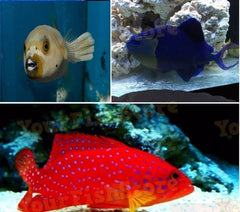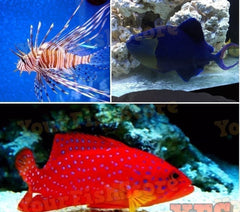X2 Lighting Maroon Clown Fish Package - Premnas Biaculeatus

x2 LIGHTING MAROON CLOWN FISH PACKAGE - PREMNAS BIACULEATUS - FREE SHIPPING
Approx: 1 1/2" - 2 1/2" Each
Buy from an Official Breeder. We thoroughly inspect each pair before they are sent off to their new home. Each Clown Fish is held for 90 days before they leave our facility to ensure proper clown gain and aggressive eating habits.
We typically feed all of our clown fish micro .5mm pellets soft/dry, and copepods.
Most of our clown fish are already hosting anemones in their holding tanks.
Minimum Tank Size: 30 gallons
Care Level: Easy
Temperament: Semi-aggressive
Reef Compatible: Yes
Water Conditions: 72-78° F, dKH 8-12, pH 8.1-8.4, sg 1.020-1.025
The Maroon Clownfish, also known as the Spine-Cheeked Anemonefish or Maroon Anemonefish, has a bold, red body color with a broad white stripe on the forehead, and white stripes on its midsection and in front of the anal fin.
Captive bred clownfish are very hardy and durable fish making them a perfect addition for the novice or seasoned aquarist. The Maroon Clownfish is a good candidate for a reef aquarium. The Maroon Clownfish are the most territorial of all clownfish species. Maroon Clownfish are very sensitive to elevated levels of copper, and should never be exposed to levels near or above .
Captive bred clownfish are easy to breed in the home aquarium. The females will be the largest of the pair, and two fish will usually stay close to each other in the aquarium. These fish are egg layers and will deposit the eggs on a flat surface, and defend the eggs from other tank mates. The eggs will normally hatch in 6-11 days depending on the temperature. The fry must be reared in a separate aquarium on a diet of rotifers then baby brine shrimp.
Caring for a maroon clownfish in a saltwater aquarium is not difficult if several husbandry considerations are kept in mind. First and foremost, it is critical for the aquarist considering one or more maroon clownfish to remember that this fish gets big, and, more often than not, will become the dominant fish in the aquarium as an adult. As such, mixing the maroon clownfish with other smaller, more peaceful fishes (especially other clownfishes) in anything but the largest aquarium is not advisable. Instead, plan to have the maroon clownfish be the centerpiece of a forty-gallon tank with a beautiful bubble anemone host, or keep a pair in a sixty-gallon or larger aquarium. These fish have all the personality, intelligence and good looks to be the main attraction.
Alternatively, consider adding a maroon clownfish as the last (or very near the last) fish in an aggressive reef tank or semi-aggressive community tank with larger fishes. While it is not unheard of for maroon clownfish to damage coral while doing some of their own aquascaping, generally speaking, they are most content in a reef tank with plenty of live rock. It’s important to remember that the maroon clownfish, like other clownfishes, doesn’t need a host anemone, so it is entirely possible to keep this fish in a fish-only system or a system that may not yet be mature enough for an anemone (usually about six months).
Whatever set-up the aquarist decides upon for his or her maroon clownfish, the aquarium set-up should employ standard saltwater aquarium filtration and lighting. If the aquarist is intent on also keeping an anemone in which the clownfish can host, then the aquarium will need to have standard reef filtration (e.g., a protein skimmer that is preferably sump-based) and reef-ready lighting.
Feeding a Maroon Clownfish
When it comes to feeding a maroon clownfish, there is usually little trouble. In the wild, the maroon clownfish will feed primarily on zooplankton and benthic algae, but in the aquarium it will accept a wide range of commercially available foods and meaty bits of raw table seafood. In fact, clownfish will accept just about any type of marine-based diet they are offered. For optimum health, feed a varied diet.
Other Considerations
There are a few other considerations to keep in mind when considering keeping maroon clownfish. It is best to acquire a mated pair if a pair is the goal, although two individuals of varying sizes (one large and one small) may pair up. If a maroon clownfish from a pair dies, the aquarist may add another maroon clownfish of approximately the same size. In either scenario, the aquarist must watch closely to insure that the dominant fish is not harassing the smaller fish to the latter’s detriment.
While the husbandry staff at Blue Zoo Aquatics recommends the aquarist quarantine all newly acquired fishes, this is particularly true in the case of wild-collected maroon clownfish. These fish are notorious for carrying various common parasites that cause infestations such as Amyloodinium, Brooklynellosis and Crypto. While we take the time to quarantine all recently imported fishes for you at our state-of-the-art facility in Los Angeles, the reality is that the stress of shipping and new surroundings can prompt an outbreak on even the healthiest-looking maroon clown. Be safe and quarantine!
Maroon clownfishes will breed readily in captivity, and, while a discussion of breeding your own maroon clownfish is beyond the scope of this article, do know that this is an excellent marine species for the captive breeder.

QUESTIONS & ANSWERS
Have a Question?
Be the first to ask a question about this.














